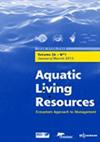Genetic parameters and response to selection for thermal tolerance, summer survival and growth in hybrid oyster (Crassostrea gigas ♀ × C. angulata ♂)
IF 1.9
4区 农林科学
Q3 FISHERIES
引用次数: 0
Abstract
The Pacific oyster Crassostrea gigas is the most commonly farmed mollusks worldwide, while its production has been hindered by massive mortalities linked to high temperatures. Selective breeding focusing on thermal tolerance is an attractive option for reducing the impact of massive mortalities, but the genetic basis underlying this trait is currently unknown. Hybridization between C. gigas and C. angulata was conducted and followed by one generation of family selection for thermal tolerance. The genetic parameters for thermal resistance, summer survival and growth and selection response were investigated by using 50 full-sibling families. The mean survival of all families ranged from 30.2 to 69.5%, reflecting the large variation of thermal tolerance in the hybrid population. The estimates of heritability for thermal tolerance were low to moderate, ranging from 0.19 ± 0.03 to 0.27 ± 0.05, confirmed that there is genetic basis for thermal tolerance. The phenotypic (r = 0.537, P < 0.01) and genetic correlations (r = 0.546, P < 0.01) between thermal tolerance and summer survival were positive and significant, while the phenotypic and genetic correlations between growth and survival (including thermal tolerance and summer survival) were positive but low (P > 0.05). High response to selection (ΔG = 36.33%) was observed after one generation of selection for thermal tolerance, and there was also corresponding response (ΔG = 14.46%) for summer survival. These results demonstrated that genetic selection to improve summer survival of oyster may be facilitated by selecting highly heat-tolerant lines.
杂交牡蛎(Crassostrea gigas♀× C)耐热性、夏季存活和生长的遗传参数及其对选择的响应angulata♂)
太平洋牡蛎长牡蛎是世界上最常见的养殖软体动物,但它的生产一直受到与高温有关的大量死亡的阻碍。以耐热性为重点的选择性育种是减少大规模死亡影响的一个有吸引力的选择,但这一特性的遗传基础目前尚不清楚。将C. gigas与C. angulata进行杂交,然后进行一代耐热性家族选择。利用50个全兄弟姐妹家系,研究了玉米耐热性、夏季存活、生长和选择反应的遗传参数。各家庭的平均成活率在30.2 ~ 69.5%之间,反映了杂交种群体的耐热性差异较大。热耐受性遗传力介于0.19±0.03 ~ 0.27±0.05之间,具有遗传基础。表型(r = 0.537, P <;0.01)和遗传相关性(r = 0.546, P <;(P > 0.01),生长与存活(包括耐热性和夏季存活)呈显著正相关,但表型和遗传相关性较低(P >;0.05)。经过一代的耐热性选择后,对选择的反应较高(ΔG = 36.33%),对夏季生存的反应也较高(ΔG = 14.46%)。这些结果表明,选择高耐热品系可以促进牡蛎夏季成活率的遗传选择。
本文章由计算机程序翻译,如有差异,请以英文原文为准。
求助全文
约1分钟内获得全文
求助全文
来源期刊

Aquatic Living Resources
农林科学-海洋与淡水生物学
CiteScore
2.30
自引率
0.00%
发文量
10
审稿时长
>24 weeks
期刊介绍:
Aquatic Living Resources publishes original research papers, review articles and propective notes dealing with all exploited (i.e. fished or farmed) living resources in marine, brackish and freshwater environments.
Priority is given to ecosystem-based approaches to the study of fishery and aquaculture social-ecological systems, including biological, ecological, economic and social dimensions.
Research on the development of interdisciplinary methods and tools which can usefully support the design, implementation and evaluation of alternative management strategies for fisheries and/or aquaculture systems at different scales is particularly welcome by the journal. This includes the exploration of scenarios and strategies for the conservation of aquatic biodiversity and research relating to the development of integrated assessment approaches aimed at ensuring sustainable and high quality uses of aquatic living resources.
 求助内容:
求助内容: 应助结果提醒方式:
应助结果提醒方式:


